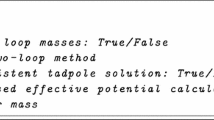Abstract
When supersymmetry is broken in multiple sectors via independent dynamics, the theory furnishes a corresponding multiplicity of “goldstini” degrees of freedom which may play a substantial role in collider phenomenology and cosmology. In this paper, we explore the tree-level mass spectrum of goldstini arising from a general admixture of F -term, D -term, and almost no-scale supersymmetry breaking, employing non-linear superfields and a novel gauge fixing for supergravity discussed in a companion paper. In theories of F -term and D -term breaking, goldstini acquire a mass which is precisely twice the gravitino mass, while the inclusion of no-scale breaking renders one of these modes, the modulino, massless. We argue that the vanishing modulino mass can be explained in terms of an accidental and spontaneously broken “global” supersymmetry.
Similar content being viewed by others
References
J. Wess and J. Bagger, Supersymmetry and supergravity, Princeton University Press, Princeton U.S.A. (1992).
D. Balin and A. Love, Supersymmetric gauge field theory and string theory, Taylor & Francis Group, New York U.S.A. (1994).
E. Cremmer et al., Spontaneous symmetry breaking and Higgs effect in supergravity without cosmological constant, Nucl. Phys. B 147 (1979) 105 [SPIRES].
E. Cremmer, S. Ferrara, L. Girardello and A. Van Proeyen, Yang-Mills theories with local supersymmetry: lagrangian, transformation laws and super-Higgs effect, Nucl. Phys. B 212 (1983) 413 [SPIRES].
S.P. Martin, A supersymmetry primer, hep-ph/9709356 [SPIRES].
D.J.H. Chung et al., The soft supersymmetry-breaking lagrangian: theory and applications, Phys. Rept. 407 (2005) 1 [hep-ph/0312378] [SPIRES].
M.A. Luty, 2004 TASI lectures on supersymmetry breaking, hep-th/0509029 [SPIRES].
J. Bagger, E. Poppitz and L. Randall, The R axion from dynamical supersymmetry breaking, Nucl. Phys. B 426 (1994) 3 [hep-ph/9405345] [SPIRES].
H.-S. Goh and M. Ibe, R-axion detection at LHC, JHEP 03 (2009) 049 [arXiv:0810.5773] [SPIRES].
D. Shih, Pseudomoduli dark matter, JHEP 09 (2009) 046 [arXiv:0906.3346] [SPIRES].
B. Keren-Zur, L. Mazzucato and Y. Oz, Dark matter and pseudo-flat directions in weakly coupled SUSY breaking sectors, JHEP 09 (2009) 041 [arXiv:0906.5586] [SPIRES].
C. Cheung, Y. Nomura and J. Thaler, Goldstini, JHEP 03 (2010) 073 [arXiv:1002.1967] [SPIRES].
C. Cheung, J. Mardon, Y. Nomura and J. Thaler, A definitive signal of multiple supersymmetry breaking, JHEP 07 (2010) 035 [arXiv:1004.4637] [SPIRES].
N. Craig, J. March-Russell and M. McCullough, The goldstini variations, JHEP 10 (2010) 095 [arXiv:1007.1239] [SPIRES].
R. Argurio, Z. Komargodski and A. Mariotti, Pseudo-goldstini in field theory, Phys. Rev. Lett. 107 (2011) 061601 [arXiv:1102.2386] [SPIRES].
J. Thaler and Z. Thomas, Goldstini can give the Higgs a boost, JHEP 07 (2011) 060 [arXiv:1103.1631] [SPIRES].
H.-C. Cheng, W.-C. Huang, I. Low and A. Menon, Goldstini as the decaying dark matter, JHEP 03 (2011) 019 [arXiv:1012.5300] [SPIRES].
M. McCullough, Stimulated supersymmetry breaking, Phys. Rev. D 82 (2010) 115016 [arXiv:1010.3203] [SPIRES].
K.I. Izawa, Y. Nakai and T. Shimomura, Higgs portal to visible supersymmetry breaking, JHEP 03 (2011) 007 [arXiv:1101.4633] [SPIRES].
K. Benakli and C. Moura, Brane-worlds pseudo-goldstinos, Nucl. Phys. B 791 (2008) 125 [arXiv:0706.3127] [SPIRES].
M.A. Luty and N. Okada, Almost no-scale supergravity, JHEP 04 (2003) 050 [hep-th/0209178] [SPIRES].
R. Rattazzi, A. Strumia and J.D. Wells, Phenomenology of deflected anomaly mediation, Nucl. Phys. B 576 (2000) 3 [hep-ph/9912390] [SPIRES].
C. Cheung, F. D’Eramo and J. Thaler, Supergravity computations without gravity complications, arXiv:1104.2598 [SPIRES].
W. Siegel and S.J. Gates, Jr., Superfield supergravity, Nucl. Phys. B 147 (1979) 77 [SPIRES].
S.J. Gates, M.T. Grisaru, M. Roček and W. Siegel, Superspace, or one thousand and one lessons in supersymmetry, Front. Phys. 58 (1983) 1 [hep-th/0108200] [SPIRES].
W.D. Linch, III, M.A. Luty and J. Phillips, Five dimensional supergravity in N =1 superspace, Phys. Rev. D 68 (2003) 025008 [hep-th/0209060] [SPIRES].
Z. Komargodski and N. Seiberg, From linear SUSY to constrained superfields, JHEP 09 (2009) 066 [arXiv:0907.2441] [SPIRES].
A.B. Lahanas and D.V. Nanopoulos, The road to no scale supergravity, Phys. Rept. 145 (1987) 1 [SPIRES].
S. Kachru, R. Kallosh, A.D. Linde and S.P. Trivedi, de Sitter vacua in string theory, Phys. Rev. D 68 (2003) 046005 [hep-th/0301240] [SPIRES].
L. Randall and R. Sundrum, Out of this world supersymmetry breaking, Nucl. Phys. B 557 (1999) 79 [hep-th/9810155] [SPIRES].
G.F. Giudice, M.A. Luty, H. Murayama and R. Rattazzi, Gaugino mass without singlets, JHEP 12 (1998) 027 [hep-ph/9810442] [SPIRES].
Author information
Authors and Affiliations
Corresponding author
Additional information
ArXiv ePrint:1104.2600
Rights and permissions
About this article
Cite this article
Cheung, C., D’Eramo, F. & Thaler, J. The spectrum of goldstini and modulini. J. High Energ. Phys. 2011, 115 (2011). https://doi.org/10.1007/JHEP08(2011)115
Received:
Revised:
Accepted:
Published:
DOI: https://doi.org/10.1007/JHEP08(2011)115



